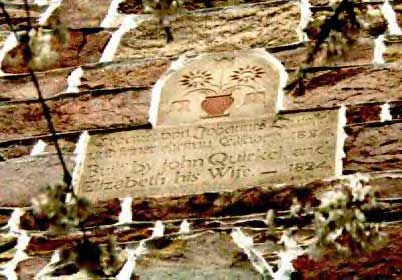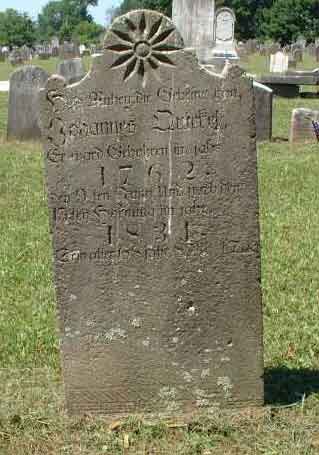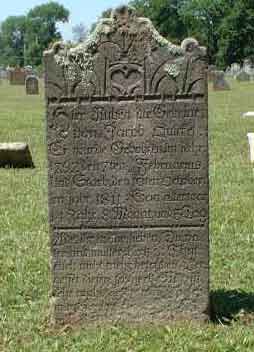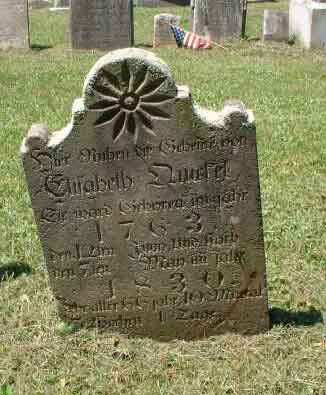Quickel Stonework, By Mr Barry Rauhauser, presently Stauffer Curator of the Lancaster County Historical Society.
The Individual Behind the Art: By Barry Rauhauser
Quicel Stonework
›››ÓThe stones of John Quickel (Photos #4, #5) appear in great contrast alongside the stones of James Kelly.› KellyŪs stones are white marble, plain, and though in German, are still carved in a plain typeface.› QuickelŪs stones are brown sandstone with hearts and tulips or suns and always fraktur lettering. John QuickelŪs father, Michael Quickel, came to America from Germany and landed in Philadelphia on July 25, 1736.› Michael settled in the Conestoga Valley in Lancaster County, remained until 1763, at which time he purchased 200 acres of land in what is now Conewago Township, just east of Dover. In 1770, Michael Quickel gave more than 2 acres to the Lutheran and Reformed church which sat at the southwest corner of his original 200 acres.› This church became known as QuickelŪs Church.› A well-respected man in the community, Michael helped teach the local children at QuickelŪs Church.› In 1776, as a Captain, Michael led a group of volunteer soldiers to Philadelphia.
›››ÓJohn Quickel, his son, was born in 1762 and baptized at StrayerŪs Church on› July 27, 1763.› Michael Quickel willed to his son the 200 acres of land which he owned.› John did not accept the conditions of his fatherŪs will and purchased 75 acres to the east of his fatherŪs land in 1787. John was probably an educated man, though IŪve found no record of his education.
› ÓIn the cemetery that sits across the road from QuickelŪs Church are many stones matching the John Quickel stones found at StrayerŪs church.› As a cross check, I sampled a variety of the sandstone gravemarkers from this yard and searched for the matching estate records of the interred. (Table 2)› The full list of all stones sampled can be seen in Data Table 1, in the back, and are distinguished by a Q in the žCem.Ó column (Editors note: I included the authorŪs tables below and at the end of the text)
žLike James Kelly, John Quickel also appears to have a long and varied carving career.› The stones in the Quickel yard are much more varied than one would conclude by› examining the few stones located at the StrayerŪs Church cemetery.› John QuickelŪs carving must have begun about the time of his fatherŪs death and continued until his own death in 1831.
›››ÓThe sampling of stones from the Quickel yard shows the variety which John Quickel carved.› Beginning with the simple, all capital-lettered, plain type, fieldstone which he carved for his father, John Quickel then moves into a period of small, undecorated, quarried sandstone markers, and then into his later years with the sun, tulips, hearts and fraktur lettering.› Large variations can also be noticed within each of the three main styles. (Photos #6, #7, #8)
›››ÓOddly enough, John Quickel never appears in any of the tax records as a stonecutter, or weaver, or mason, or anything that one would normally connect with gravestone carving.› John Quickel is usually found as žEsquireÓ in the tax records due to his 12 year career as a Justice of the Peace.› However, John Quickel leaves behind some record suggesting that he was a stone carver.
- Table 3:› from John QuickelŪs Inventory Appraisal
to two Stone Jocks› .75
to a books and stone cutting tools› .75
to Hammer, anvill, Tom Hock, pincher, chisel & stone wedges .75
to a lot of Himm & prayer books 2.50›
žIn his administration account, John QuickelŪs estate pays his son George Quickel for one tombstone.(
› žThe discussion of the Quickel carvers canŪt be concluded without also noting the portions of the written record which do not point to a Quickel as the carver.› In my opinion, these are momentarily unexplainable anomalies to an otherwise perfect case for the Quickels as carvers.› However, the written record does point wherever it will.
›››ÓOne of the problems with the QuickelŪs case is found on the stone of Barbara Spahr, dated 1823, and found at StrayerŪs Church (
ž But George SpahrŪs estate also pays Melchoir Benedick for a stone for žBarbary SpahrÓ, indicating his wife.› This would indicate a stone that is otherwise identical to the works of John Quickel.(Photo #11)› The explanation may be lost with time.› George Spahr may have been repaying Benedick for a stone that had previously been carved by John and purchased by Benedick.
›››ÓAnother problem lies in the stones at QuickelŪs Church which contain QuickelŪs sun motif carved into marble. (Photo #12)› Only one administration account has been located for these stones.› This single account indicates that James Kelly was paid for the stone.› Here again, at the moment, the story is lost.› Kelly could have copied the work of Quickel with enough skill.› He could have even used some of the same stencils.› Better still, John Quickel may have carved the stone for Kelly.› None of these possibilities should otherwise detract from the evidence which supports John and George Quickel as the carvers of many of the gravestones in the area› After John Quickel dies, and especially after George Quickel dies, the use of sandstone, fraktur lettering, and Germanic folk-motifs drops rapidly from the faces of the gravestones.› The final two carvers, for which I have found more than one mention in the probate records, are Michael Christ and John Minter.› Both appear to be marble carvers who use more dominant, widespread cultural symbols (fans or willow and urns) or no symbols at all.› Both have something greater in common, however, and that is their locations to the west of the Dover area.
›››ÓMichael Christ does not leave much information behind.› The Pennsylvania census for 1800 indicates a Michael Christ living in Paradise Township to the west of Dover and the 1820 census shows a Michael Christ residing in Menallen Township in Adams County.› The tax records of 1800 for Paradise Township show a Michael Christ as a small land owner.› By 1804, Michael Quickel is listed as a weaver.› The connection of weaver and gravestone maker› is not uncommon and occurs with John Frysinger, mentioned only one time in an estate record from 1809, who also is listed as a weaver in the tax records.
› žJohn Minter is absent from many of the York County records.› Like Christ, he ended up residing in the Adams County area.› The Pennsylvania Census of 1820 lists a John Minter in Montgomery County and in 1840 lists John Minter in Franklin Township in Adams County.› BoydŪs Business Directory of 1860 lists John Minter as a marble worker in Hanover with a shop at the corner of Carlisle and Chestnut. #5››› Both MinterŪs and ChristŪs stones must have been brought in from much greater distances to the west.› When George Quickel dies, his estate purchases a stone from Minter.
››ÓWhich comes first?› The carver or the culture?› If I would have answered that question last semester I would have chosen culture.› I assumed that the individual on the deathbed would have been controlling the characteristics of the stones prior to 1850. Therefore, the carver appeared to me as a servant to the regional culture and to the individual and was somehow anonymous both in signature and influence.
››Ó Just as Aries had also discovered, after examining many of the available wills, I found no demands placed on the executors other than a žburial in a Christian-like mannerÓ and the occasional› žbefitting social gracesÓ and always žat the discretion of the executors.Ó #6››› If the individual did select a style of stone, it is not found in their wills, and was probably done so informally.› One of the carvers, John Quickel, changes his style dramatically over the years and from stone to stone.› This demonstrates that, to John Quickel at least, there was individuality in the carving of a stone.› Though the individuality and symbols may have been influenced by culture, there are still elements of the carvings which remained independent of any dominant culture.
››ÓBut the characteristics of the tombstones are not controlled solely by the time periodŪs regional culture of death or the carverŪs artistic interpretations.› Economy also would have controlled these characteristics.› The gravestones are influenced by the availability of material and a carverŪs talent.› The culture, the carver, and the economy, mesh into a single tangible unit; the gravestone.› Without examining the written record, as I did last semester, I could only guess at the economy, and only imagine the carvers behind the stones.› This left two broad areas of darkness without any light switches. .....
žThe people at StrayerŪs were not paying more money to have sandstone, but they were paying more money to maintain their culture through the German folk art and fraktur lettering.› The best example of this can be seen with the Quickel/Kelly marble stones which appear at the QuickelŪs Church cemetery.› The one available administration account for a marker of this type from 1815 gives a price of $43.25.› This means it cost three times as much to have both marble and the Germanic cultural elements in the same stone.
›››ÓThe folk art's relevance to the German culture is easy enough to visually deduce.› Even last semester, I knew that the folk art was a distinctly German element in the stones of carvers such as John Quickel.› The importance of fraktur lettering as a German cultural element can only be understood when one looks at a copy of YorkŪs German Gazette from the time period. › Both John QuickelŪs and George SpahrŪs obituaries were printed in the German Gazette.› However, the papers from these dates are no longer extant. ››› After seeing copies of the German Gazette, printed in a fraktur lettering similar to John QuickelŪs, I now view the lettering not as decoration but as a symbol of Germanic culture.
›››ÓThere was much more tension between the German immigrants and the dominant Anglican culture of America than I had perceived.› The first marker in StrayerŪs cemetery that uses fraktur lettering is dated 1808.› Before this, the carvers were probably skilled enough to carve in fraktur, yet it does not appear.› Mounting tension between the cultures, though possibly unconscious and peaceful, may have caused this increase in the use of fraktur lettering.› Originally, I viewed the fraktur-lettered stones as the ždirect-from-GermanyÓ culture; I viewed their disappearance as assimilation without a struggle.› I now believe that this fraktur lettering was a reaction to the assimilation.
›››ÓThis cultural tension can best be seen in John QuickelŪs stones. Though most of the fraktur-lettered markers are those carved by John Quickel, he himself undergoes a change in lettering styles.› By examining the estate records and markers of QuickelŪs Church, IŪve found that John Quickel does not begin to carve in fraktur until about 1802.› Many of his earlier stones are still beautifully carved, but are in žstandardÓ capital letters. John Quickel may have been copying the fraktur from an old family bible, or he may have been copying from issues of YorkŪs German Gazette.› Either way, he used the fraktur lettering not out of fashion, but out of an effort to maintain a culture.› John QuickelŪs use of fraktur and folk art motifs increased as the years passed and as the assimilation of the German culture continued.
››ÓJohn Quickel demonstrates the importance of the carver.› As the popular carver of what I now view as žstubbornly German" markers, John Quickel becomes not just a carver, but a stronghold of German culture.› When John Quickel died in 1831, a small segment of the German immigrant culture died with him.› Even in the QuickelŪs Church cemetery, there are few, if any, folk art motifs after 1831.› The fraktur-lettered stones which appear after this date are carved by George Quickel and others who are mimicking the style of John Quickel, yet they are no match for the dominant culture or the rapidly assimilating German culture.
›››ÓThis also demonstrates the importance of generational changes occurring in a culture.› Last semester, I found a big generational culture leap due to the use of English in the schools in Dover.› Within ten years, the German language disappears from the markers at StrayerŪs cemetery.› With John and George Quickel, we see the same thing on a micro-level.› In this case, the disappearance of an important cultural element, the German folk-art on tombstones, occurs in the exhale of a breath.
›››ÓAnother overlooked aspect in last semesterŪs study was the influence of canals.› In an interview with the present owner of the Quickel house, Paul Fuller, I accidentally discovered this influence on the Dover area.› Mr. Fuller stated that a canal was planned along the Conewago in the early 1800Ūs.› The investors of this canal had shipped in large quantities of sandstone into the area, but had gone out of business before anything was ever built.› According to Fuller, these stones were then used by many of the local residents to build houses and barns.› To Mr. Fuller, this explained the variegated coloring on many of the areaŪs old stone houses.›
›››ÓIŪve found absolutely nothing concrete to verify this story.› It may be nothing more than rural myth.› The area itself is broad enough to explain some of the variation of color of sandstone.› However, IŪve found no evidence which denies his claim.› In fact, according to William Shank, in The Amazing Pennsylvania Canals, many upstart companies were trying to build side canals which led into the Susquehanna, but had run out of money. The Conewago streams, which ironically parallel Canal Road next to the Quickel house, would have been a perfect site for a canal since they would have led into the Conewago Falls Canal along the Susquehanna.
›››ÓThe people of the Dover area must have been acquainted with the canal systems in the Susquehanna.› Balzer Hamme, one of the men with a Quickel stone in StrayerŪs cemetery, was a trade merchant who trafficked goods between Pittsburgh, Philadelphia and Baltimore.›› Hamme was probably using the Susquehanna and its canals to take goods to Baltimore. The overall influence of the canals before railways can also be seen from an advertisement by Byrnes and Co. in the Gazette in Fig. 2.
›››ÓThe canals may not explain the colors of the sandstone in Dover, but it does explain the Minter stones, which come from Hanover, and the Christ stones, which also came from western areas.› Before railway, east to west trade routes would have been established to take advantage of these canals and the Susquehanna River.› Even though railway was established by the time of MinterŪs appearance, the roadways and trade patterns had already been established, making Hanover as likely a place to obtain a tombstone as York.› Depending on the availability of economically appropriate carvers in each area, Hanover may have been a better choice.› Growing up with the availability of north to south Interstate Highways, the prevalence of east to west trade in the nineteenth century never even occurred to me.
› ž Now that IŪve mentioned many of the things that I misconstrued by only examining the material record last semester, let me mention one thing I got right.› As I said last semester, I donŪt agree with Barba about much of the symbolism which he suggests.› The only symbolic importance I may have seen was that of the drooping tulip branches. #11››› However, after seeing the folk art datestone on the Quickel house, I think even this is a bit of a stretch.› The folk art stems from the home and the family and is symbolic of these.› After viewing the stones at the Quickel cemetery, I now see the sun motif as an economical German cultural statement, rather than a transitional folk art motif.› The real importance with the folk art, I believe now, is as its symbol of a German culture to a people who found their culture under stress. ž
Table
1:› Possible Carvers from the Probate Records
Year Carver Materia Motif Price
1795 Horn, Frederick 2 7 5..4..0
1806 Horn, Frederick 2 7 6..14..11
1809 Frysinger, John 4 4 3..15..0
1809 Smith, Henry 2 7 3..18..9
1813 Kelly, James 2 7 12.72
1815 Kelly, James 2 7 16.75
1819 Kelly, James 2 7 19.00
1819 Kelly, James 2 7 19.48
1820 Kelly, James 2 7 18.11
1822› Quickel, John 4 9› 9.00
1825 Kelly, James 2 7 19.80
1826 Quickel, John 4 4 26.00
1828 Quickel, John 4 9 24.00
1830 Quickel, George 4 9 11.50
1833 Christ, W. or M. 2 10 18.00
1837 Christ, Michael 4 10 17.00
Table
2: Matching John Quickel records at QuickelŪs Church
Date Interred Carver Material Motif Price Paid
1787› Quickel, Michael Quickel, John 4 caps 1..10..0
1804 Finck, Heinrich Quickel, John 4 4 1..17..6
1804 Cron, Johann Phillip Quickel, John 4 4 2..5..0
1806 Hoffman, Johann Phillip Quickel, John 6 4 6..15..0 for 2
1816 Benedick, George Quickel, John 4 4 21.84
1818 Miller, George Quickel, John 4 4 26.42
1823 Metzger, Willhelm Quickel, John 4 caps 58.25 for 3
1823 Wilt, John Quickel, John 4 4 16.25›" 1







